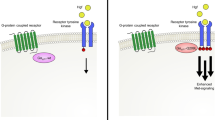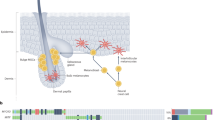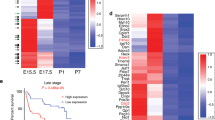Abstract
To gain insight into melanoma pathogenesis, we characterized an insertional mouse mutant, TG3, that is predisposed to develop multiple melanomas1,2. Physical mapping identified multiple tandem insertions of the transgene into intron 3 of Grm1 (encoding metabotropic glutamate receptor 1) with concomitant deletion of 70 kb of intronic sequence. To assess whether this insertional mutagenesis event results in alteration of transcriptional regulation, we analyzed Grm1 and two flanking genes for aberrant expression in melanomas from TG3 mice. We observed aberrant expression of only Grm1. Although we did not detect its expression in normal mouse melanocytes, Grm1 was ectopically expressed in the melanomas from TG3 mice. To confirm the involvement of Grm1 in melanocytic neoplasia, we created an additional transgenic line with Grm1 expression driven by the dopachrome tautomerase promoter. Similar to the original TG3, the Tg(Grm1)EPv line was susceptible to melanoma. In contrast to human melanoma, these transgenic mice had a generalized hyperproliferation of melanocytes with limited transformation to fully malignant metastasis. We detected expression of GRM1 in a number of human melanoma biopsies and cell lines but not in benign nevi and melanocytes. This study provides compelling evidence for the importance of metabotropic glutamate signaling in melanocytic neoplasia.
This is a preview of subscription content, access via your institution
Access options
Subscribe to this journal
Receive 12 print issues and online access
$209.00 per year
only $17.42 per issue
Buy this article
- Purchase on Springer Link
- Instant access to full article PDF
Prices may be subject to local taxes which are calculated during checkout






Similar content being viewed by others
References
Chen, S., Zhu, H., Wetzel, W.J. & Philbert, M.A. Spontaneous melanocytosis in transgenic mice. J. Invest. Dermatol. 106, 1145–1150 (1996).
Zhu, H. et al. Development of heritable melanoma in transgenic mice. J. Invest. Dermatol. 110, 247–252 (1998).
Colon-Teicher, L. et al. Genomic sequences capable of committing mouse and rat fibroblasts to adipogenesis. Nucleic Acids Res. 21, 2223–2228 (1993).
Budd, P.S. & Jackson, I.J. Structure of the mouse tyrosinase-related protein-2/dopachrome tautomerase (Tyrp2/Dct) gene and sequence of two novel slaty alleles. Genomics 29, 35–43 (1995).
Mackenzie, M.A., Jordan, S.A., Budd, P.S. & Jackson, I.J. Activation of the receptor tyrosine kinase Kit is required for the proliferation of melanoblasts in the mouse embryo. Dev. Biol. 192, 99–107 (1997).
Reedy, M.V., Parichy, D.M., Erickson, C.A., Mason, K.A. & Frost-Mason, S.K. Regulation of Melanoblast Migration and Differentiation. in The Pigmentary System: Physiology and Pathophysiology (eds. Nordlund, J.J., Boissy, R.E., Hearing, V.J., King, R.A. & Ortonne, J.P.) (Oxford University Press, New York, 1998).
Skerry, T.M. & Genever, P.G. Glutamate signalling in non-neuronal tissues. Trends Pharmacol. Sci. 22, 174–181 (2001).
Hermans, E. & Challiss, R.A. Structural, signalling and regulatory properties of the group I metabotropic glutamate receptors: prototypic family C G-protein-coupled receptors. Biochem. J. 359, 465–484 (2001).
Aiba, A. et al. Deficient cerebellar long-term depression and impaired motor learning in mGluR1 mutant mice. Cell 79, 377–388 (1994).
Aiba, A. et al. Reduced hippocampal long-term potentiation and ontext-specific deficit in associative learning in mGluR1 mutant mice. Cell 79, 365–375 (1994).
Conquet, F. et al. Motor deficit and impairment of synaptic plasticity in mice lacking mGluR1. Nature 372, 237–243 (1994).
Dhanasekaran, N., Heasley, L.E. & Johnson, G.L. G protein–coupled receptor systems involved in cell growth and oncogenesis. Endocr. Rev. 16, 259–270 (1995).
Gutkind, J.S. Cell growth control by G protein–coupled receptors: from signal transduction to signal integration. Oncogene 17, 1331–1342 (1998).
Takano, T. et al. Glutamate release promotes growth of malignant gliomas. Nat. Med. 7, 1010–1015 (2001).
Rzeski, W., Turski, L. & Ikonomidou, C. Glutamate antagonists limit tumor growth. Proc. Natl. Acad. Sci. USA 98, 6372–6377 (2001).
Frati, C. et al. Expression of functional mGlu5 metabotropic glutamate receptors in human melanocytes. J. Cell. Physiol. 183, 364–372 (2000).
Jhappan, C. et al. TGFα overexpression in transgenic mice induces liver neoplasia and abnormal development of the mammary gland and pancreas. Cell 61, 1137–1146 (1990).
Zhu, H., Ryan, K. & Chen, S. Cloning of novel splice variants of mouse mGluR1. Brain Res. Mol. Brain Res. 73, 93–103 (1999).
Sood, R. et al. Cloning and characterization of a novel gene SHPRH encoding a conserved putative protein with SNF2/helicase and PHD-finger domains from 6q24 region. Genomics (in the press).
Zhu, H. et al. Development of early melanocytic lesions in transgenic mice predisposed to melanoma. Pigment Cell Res. 13, 158–164 (2000).
Acknowledgements
We thank I. Jackson and G. Merlino for the Dct expression construct; V. Hearing for the Tyrp1 antibody; L. White for human melanocytes; J. Welch, M. Galdzicki and E. Eddings for technical help; and A. Weereratna, K. Sweder, L. Wise, R. Zhou and members of W.J.P.'s laboratory for helpful discussions. This work was supported by a Collaborative Research Award from the Cancer Institute of New Jersey (S.C. and J.G.), The Ohl Cancer Foundation (S.C.), New Jersey Commission on Cancer Research (S.C.), National Cancer Institute (S.C.) and National Institute of Environmental Health Sciences (S.C. and K.R.R.). P.M.P. was supported by an Australian National Health and Medical Research Council CJ Martin postdoctoral fellowship. K.C.-S. was supported by a fellowship from La Fondation Pour la Recherche Médicale.
Author information
Authors and Affiliations
Corresponding author
Ethics declarations
Competing interests
The authors declare no competing financial interests.
Rights and permissions
About this article
Cite this article
Pollock, P., Cohen-Solal, K., Sood, R. et al. Melanoma mouse model implicates metabotropic glutamate signaling in melanocytic neoplasia. Nat Genet 34, 108–112 (2003). https://doi.org/10.1038/ng1148
Received:
Accepted:
Published:
Issue Date:
DOI: https://doi.org/10.1038/ng1148
This article is cited by
-
Genetic analysis of familial predisposition in the pathogenesis of malignant pleural mesothelioma
Journal of Cancer Research and Clinical Oncology (2023)
-
A phase Ib dose-escalation study of troriluzole (BHV-4157), an oral glutamatergic signaling modulator, in combination with nivolumab in patients with advanced solid tumors
European Journal of Medical Research (2022)
-
Blood glutamate scavengers increase pro-apoptotic signaling and reduce metastatic melanoma growth in-vivo
Scientific Reports (2021)
-
Tumor-induced neurogenesis and immune evasion as targets of innovative anti-cancer therapies
Signal Transduction and Targeted Therapy (2020)
-
Loss of CYLD accelerates melanoma development and progression in the Tg(Grm1) melanoma mouse model
Oncogenesis (2019)



